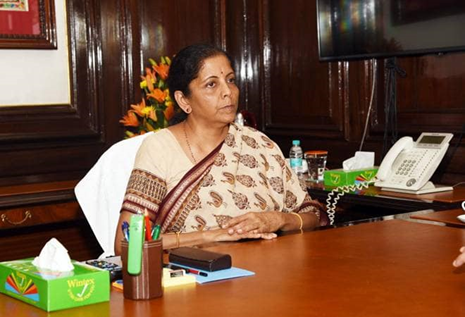Summary
The Indian Budget for 2020-21 was disappointing in that it failed to introduce measures for economic reforms. At the same time, it included a number of ideas that have been at the heart of the Rashtriya Swayamsevak Sangh (RSS). Overall, it was a conservative, political budget, furthering the ideology of the RSS.
The Indian Budget was presented by the Finance Minister Nirmala Sitharaman in the Indian Parliament on 1 February 2020 and contained little that could be termed path breaking. In fact, the Economic Survey, which was presented to the Parliament just a day before, contained many ideas that were new, and spoke refreshingly of a market-driven economy, where wealth creation and entrepreneurship would be rewarded, crony capitalism would be replaced by free markets with equal opportunities for all, inefficient public sector units would be sold, and a number of free market ideas that were refreshing as well as promising. However, the budget has not taken up any of these for implementation, and the disjoint between the reformers and the pragmatic accountants in the government appears to be continuing.
To be fair, even in the past, the Narendra Modi government has reserved its major programme and implementation announcements outside the budget, relegating the budget exercise to a safe, conservative, accounting exercise. Clearly, this year is no exception. In part, it stems from a mindset where major announcements are made by the executive, most often the prime minister, whereas putting it inside the budget would entail parliamentary scrutiny and discussions. Secondly, this is not a government that is committed to reform and, in many ways, allows politics and the voter to decide on economic decisions. As an example, the super- rich tax introduced last July for those with incomes above ₹2 crores (S$400,000) would net hardly ₹5,000 crores (S$1 billion), but the optical impact of punishing the wealth for their riches would have a good effect on the voting public. There is very little difference in perception of voter politics between this and the Indira Gandhi era, both keeping their eye firmly on the electorate. Therefore, there is little room for right wing ideas or ideology in their actions, and this budget reinforces that.
There are interesting points of note. The announcements in regard to agriculture, food processing and logistics are a teaser for state governments to follow up with programmes that would then get some central funding. Medical schools attached to district hospitals on a public-private partnership mode might lead to greater interest in setting up medical colleges by the private sector, especially in Tamil Nadu. In the same vein, encouraging education, skill development and specific vocational programmes may enthuse private players to venture into these areas and, again, Tamil Nadu has a history of such entrepreneurship.
The announcement that there would be an initial public offering for the Life Insurance Corporation of India is welcome. It has emerged as the single institution to bail out the government by investing in difficult accounts like the Industrial Development Bank of India (IDBI) and through paying large dividends to the government. As a result, it is also showing some signs of stress. Infusion of public shareholding would ensure transparency, accountability as well as capital into this undertaking, whose customers run into the millions. Disposing the IDBI through retail share sale is also a good idea.
Most importantly, the growth projections are realistic. A nominal gross domestic product (GDP) growth rate of 10 per cent has been estimated, which translates, net of inflation, into a real growth of just around six per cent, which is modest and achievable. This conservative approach has enabled the government to project a fairly reasonable increase in market borrowings for next year, up from ₹4.99 lakh crores (S$1 trillion) this year to ₹5.39 lakh crores (S$1.1 trillion). This is a modest increase and will not crowd out funds for private investment. There is a reduction in debt to GDP ratio, which is good. These two steps would likely keep the currency range-bound and, given the fairly steady expectations of oil prices, would reduce impact of price rises due to global factors. The fallout is the slippage in the fiscal deficit, though compared to the slippage announced in Finance Minister P Chidambaram’s budget after the global financial crisis, is very modest. There is also added transparency in providing other off budget commitments as liabilities in an annexure, and hopefully, these would find their place into the main accounts in the coming years.
The relief in income tax rates would benefit those earning up to ₹15 lakhs (S$30,000) a year. Perhaps there is a message here. This would benefit the youth, mostly in the organised employment sectors like information technology and manufacturing, and there is a hope that this is a consumer set that would perhaps spend more. The removal of the dividend distribution tax to be paid by companies is welcome in that it provides greater room for investment as well as for sharing. The Finance Minister has announced that she had done away with a number of exemptions under the Income Tax Act, which would require greater study.
Finally, the offer of settlement of all disputed income tax cases through payment of the tax amount without penalty or interest is a good offer. Not only would it remove a large number of cases in various courts and tribunals, it would also help draw in some revenues this year.
Dr S Narayan is Visiting Senior Research Fellow at the Institute of South Asian Studies (ISAS), an autonomous research institute at the National University of Singapore (NUS). He is a former Chief Economic Advisor to the Prime Minister of India. He can be contacted at snarayan43@gmail.com. The author bears full responsibility for the facts cited and opinions expressed in this paper.
Photo Credit: Government of India, Ministry of Finance
-
 More From :
More From :
-
 Tags :
Tags :
-
 Download PDF
Download PDF



